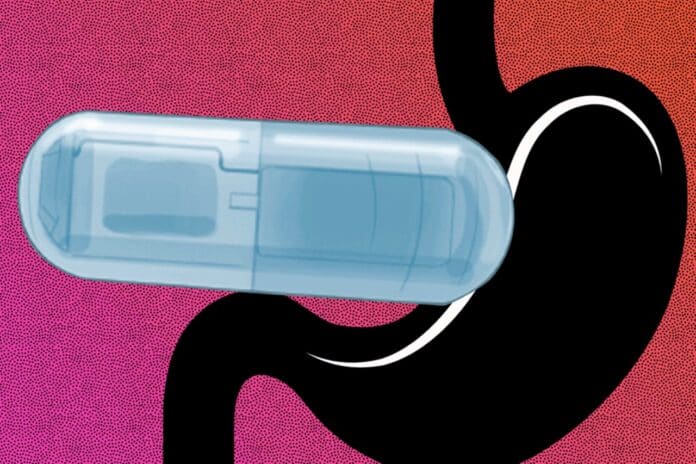When you eat a lot, your stomach tells your brain you’re full, so you stop eating. Drinking water before meals can help with this. MIT engineers made a pill that vibrates in your stomach, fooling it into feeling full.
Giving animals the pill 20 minutes before eating made them feel full and reduced their food intake by 40%. If it’s safe for humans, this pill could be a simple way to treat obesity, according to researchers.
Shriya Srinivasan, Ph.D. ’20, a former MIT graduate student and postdoc now an assistant professor of bioengineering at Harvard University, said, “For somebody who wants to lose weight or control their appetite, it could be taken before each meal. This could be interesting because it would provide an option to minimize the side effects we see with the other pharmacological treatments out there.”
Srinivasan is the lead author of the new study, which appears today in Science Advances. Giovanni Traverso, an associate professor of mechanical engineering at MIT and a gastroenterologist at Brigham and Women’s Hospital, is the paper’s senior author.
When the stomach becomes distended, specialized cells called mechanoreceptors sense that stretching and send signals to the brain via the vagus nerve. As a result, the brain stimulates the production of insulin production and hormones such as C-peptide, Pyy, and GLP-1. These hormones help people digest food, feel full, and stop eating. At the same time, ghrelin levels, a hunger-promoting hormone, go down.
While a graduate student at MIT, Srinivasan became interested in controlling this process by artificially stretching the mechanoreceptors that line the stomach through vibration. Previous research has shown that a pulse applied to a muscle can induce a sense that the power has been pushed farther than it has.
Srinivasan said, “I wondered if we could activate stretch receptors in the stomach by vibrating them and having them perceive that the entire stomach has been expanded to create an illusory sense of distension that could modulate hormones and eating patterns.”
While at MIT’s Koch Institute for Integrative Cancer Research, Srinivasan collaborated with Traverso’s lab, which is known for innovative oral drug delivery methods. Together, they created a small vibrating capsule, similar to a multivitamin, powered by a silver oxide battery. Once in the stomach, the tablet dissolves its gelatinous membrane in acidic fluids, activating the vibrating motor. In animal studies, the vibrating pill triggered mechanoreceptors, signaling the brain through the vagus nerve. Hormone levels mirrored those released after a meal, even when the animals hadn’t eaten.
After activating the vibrating pill for about 20 minutes before feeding, animals ate 40% less and gained weight more slowly. This significant change uses the body’s natural system instead of external treatments. Traverso says this approach may help overcome challenges and costs related to delivering biologic drugs.
The current pill vibrates in the stomach for 30 minutes. However, the researchers aim to explore extending its duration, allowing wireless on/off control. In animal tests, the pills pass through the digestive tract in four to five days without causing harm or obstruction.
The researchers suggest that this pill could be an alternative for treating obesity, providing a non-invasive option compared to existing approaches. Traditional methods like diet and exercise sometimes fall short. At the same time, current medical interventions, such as gastric bypass surgery or gastric balloons, can be invasive and pose safety concerns.
Although drugs like GLP-1 agonists can help with weight loss, they often require injections and are costly. MIT’s capsules, according to Srinivasan, could be produced at a more affordable cost, making them accessible to those who can’t afford pricier treatment options.
The researchers aim to make their obesity treatment device cost-effective for widespread use. They envision it transforming care, especially in global health settings where expensive options may not be accessible. The following steps involve scaling up capsule manufacturing for human clinical trials to ensure safety and determine the best timing and frequency for consumption before meals.
Developing this vibrating, ingestible capsule represents a promising step towards a non-invasive and potentially cost-effective treatment for obesity. As the research progresses, it holds the potential to address the significant global health issue of obesity, particularly in regions with limited access to advanced medical interventions.
Journal reference:
- SHRIYA S. SRINIVASAN, AMRO ALSHAREEF et al., A vibrating ingestible bioelectronic stimulator modulates gastric stretch receptors for illusory satiety. Science Advances. DOI: 10.1126/sciadv.adj3003.
